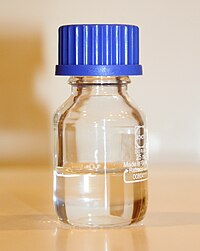
Photo from wikipedia
In this study, the geometry, spectroscopic characteristics and coordination patterns of three biologically active ligands and their Co(II) and Pd(II) complexes were explored using both experimental and theoretical techniques. The heterocyclic ligands (HL1–HL3)… Click to show full abstract
In this study, the geometry, spectroscopic characteristics and coordination patterns of three biologically active ligands and their Co(II) and Pd(II) complexes were explored using both experimental and theoretical techniques. The heterocyclic ligands (HL1–HL3) were synthesized by condensation reactions of 2-amino-6-methoxybenzothiazole with 2-hydroxy-1,4-naphthoquinone (1), 2-hydroxynaphthaldehyde (2) and 2-hydroxy-3-methoxybenzaldehyde (3). Co(II) and Pd(II) complexes of the ligands were subsequently synthesized and characterized using spectroscopic techniques, magnetic, conductance measurement and elemental analysis. The results of the spectroscopic analysis showed that the coordination of HL1 to the metal ions was through the oxygen atom of one of the carbonyl groups and the nitrogen atom of the deprotonated amine group. However, HL2 and HL3 were coordinated to the metal ions through the nitrogen atom of the azomethine group and the oxygen atom of the deprotonated hydroxyl group, resulting in N, O chromophores around the central metal ions. The magnetic moment and electronic spectra results of the metal complexes were consistent with the adoption of square planar geometry for the palladium(II) complexes and octahedral geometry for the cobalt(II) complexes. The compounds displayed good antibacterial activity against some clinically isolated bacterial strains of Escherichia coli, Klebsiella pneumonia, Pseudomonas aeruginosa, Staphylococcus aureus and Bacillus cereus. Molecular docking studies gave possible molecular targets of the various bacterial cells by the compounds. In most cases, the new compounds showed better molecular binding interactions than the crystallographic inhibitors. The antioxidant potentials of the ligands were evaluated using DPPH radical scavenging and ferrous ion chelating assays. The Fe(II) ion chelating potentials of the ligands were in the order HL3 < HL2 < HL1, with IC50 of 85 µg/mL, 69 µg/mL and 41 µg/mL, respectively. Similarly, the DPPH radical scavenging capacity of the ligands were in the descending order of HL1 > HL2 > HL3 with an IC50 of 35 µg/mL, 56 µg/mL and 96 µg/mL, respectively. The compounds could be important constituents in the synthesis or development of antibiotics and antioxidant drugs.
Journal Title: Research on Chemical Intermediates
Year Published: 2018
Link to full text (if available)
Share on Social Media: Sign Up to like & get
recommendations!